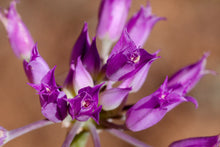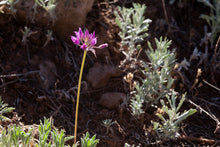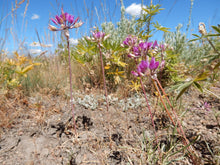
Allium acuminatum
In late spring and early summer Hooker’s onion, also known as tapertip onion, explodes into bright magenta blooms that look like delicate fireworks balancing on its narrow stem. All parts of the plant have a pungent onion odor and taste, making it edible in small doses and exceptionally attractive to pollinators while repelling garden pests. It is also unattractive to deer.
- Plant type/canopy layer: deciduous, perennial, herbaceous plant
- Size at maturity: 0-12" tall, 0-12" wide
- Light requirements: full to mostly sunny
- Moisture requirements: dry soil
- Bloom time: May - July
- Growth rate/ease: medium growth rate, easy to grow
- Wildlife support: flowers attract and provide nectar to hummingbirds, adult butterflies, bees and other insect pollinators; overall plant attracts beneficial and pest-eating insects
- Native habitat/range: common in open, usually rocky places, below 2000m, generally east of the Coast Range throughout Oregon, Washington, northern California and British Columbia. Portland Plant List - yes.
- Special features & uses: bulbs, leaves and bulblets are edible, very potent and have been used by native people for thousands of years, but should only be consumed in small doses; drought tolerant; deer resistant; landscape uses include rock gardens, pollinator gardens and meadowscapes
What to Expect + Gardening with Hooker’s Onion: For spring orders, depending on weather and the date of your order pick-up, spring bulbs may be just emerging or already done for the season. Alliums are generally less fussy and can easily be planted in spring, as long as it's done with care. For fall orders, you can expect what looks like a pot of dirt. The bulb inside will likely appear shriveled, which is its normal, dormant fall look. Fall is generally considered an excellent time to plant bulbs.
This wild allium is best suited for fully to mostly sunny dry hillsides and rocky meadows with great drainage. It is exceptionally drought tolerant and excellent for pollinator-friendly rock and xeric gardens. Bulblets reproduce easily and form dense clusters that can be divided either before or after they bloom. It also spreads slowly by seed over time.
Photo Credit 1 & 4: "Allium acuminatum" by Matt Lavin is licensed under CC BY-SA 2.0
Photo Credit 2 & 3: "Allium acuminatum" by aspidoscelis is marked with CC0 1.0







